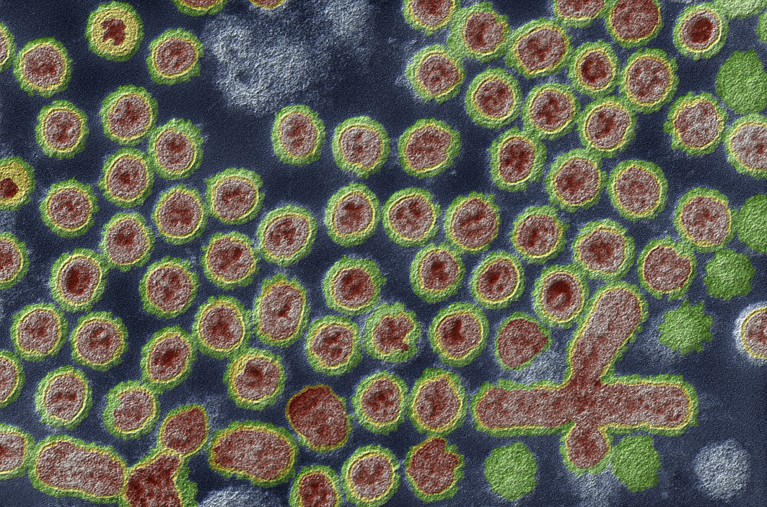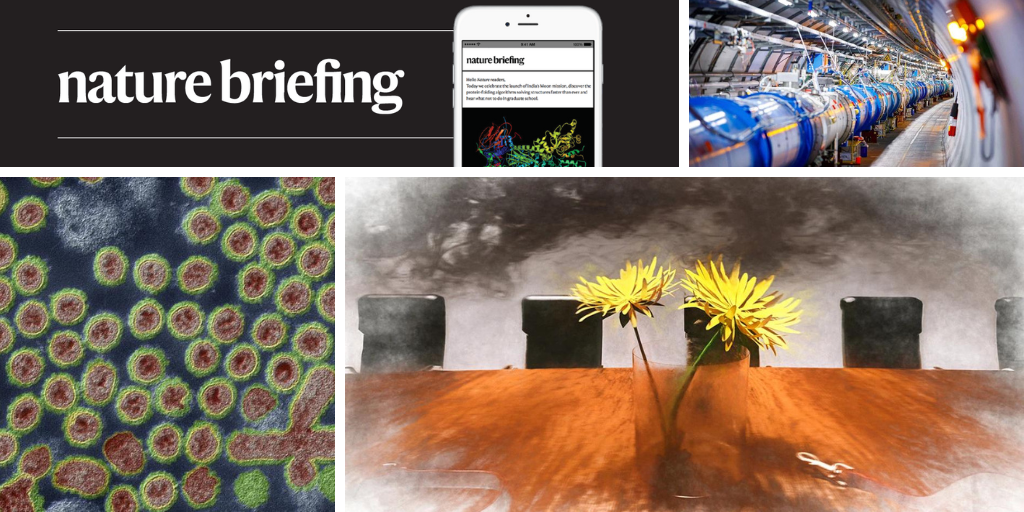Hello Nature readers, would you like to get this Briefing in your inbox free every day? Sign up here.

These bird flu virus particles (artificially coloured) were imaged by an electron microscope.Credit: Eye of Science/Science Photo Library
A case of bird flu in Missouri has researchers concerned because the infected person had no known contact with potential animal carriers of the disease. The United States is experiencing an ongoing outbreak of H5N1 avian influenza in dairy cattle. Data from this new case could reveal whether it’s reached a dreaded turning point: the emergence of a virus capable of spreading from human to human. But patchy data are leaving scientists frustrated — Missouri has no requirement for farmers to test cows for H5N1 and the country has failed to get a handle on exactly how the virus is spreading.
CERN, Europe’s particle-physics lab, will end its collaboration with the Russian Federation on 30 November because of the invasion of Ukraine. The split means the loss of millions in funding and hundreds of scientists affiliated with Russian institutes, unless they move to establishments outside of the country. CERN will continue to work with Russia-based scientists through a separate agreement with the country’s Joint Institute for Nuclear Research — an arrangement that has sparked criticism from some scientists. Others argue against restrictions on scientific cooperation.
Three scientists involved in developing drugs that mimic a hormone called glucagon-like peptide 1 (GLP-1) are among the winners of this year’s prestigious Lasker Awards. Joel Habener, Svetlana Mojsov and Lotte Bjerre Knudsen each contributed to the work that led to blockbuster obesity and diabetes drugs such as Ozempic and Wegovy. The Lasker Awards honour important advances in medical research and are often considered an early hint of who will win a Nobel Prize.
Features & opinion
Well-chosen ‘deintensification’ of cancer care can help people and the planet, argue four cancer researchers. The practice can involve, where appropriate, fewer or shorter treatments, lower doses, or omitting or substituting a therapy. For patients, “less treatment means fewer side effects, less time away from home, and reduced out-of-pocket costs”, they write. For health systems, it means less expense, less waste and a lower carbon footprint. But it will take a change in perspective, and well-designed research, to support the shift.
Futures: Science fiction from Nature
Humans prove less appealing than dandelions to visiting aliens in Bad Dog and two women try to navigate an intrusively networked future in Dreams of the East Elevens.
Nature | 6 min read & Nature | 6 min read
Astronomers have spotted a pair of enormous jets shooting from a supermassive black hole. Jets form when matter is ionized and flung out of a black hole, creating powerful structures in space. With a combined length of 23 million light years, roughly the equivalent of 223 Milky Way galaxies stacked on top of each other, they’re the biggest ever discovered, far exceeding the maximum size physicists believed jets could reach. “From a theoretical perspective it is kind of surprising that they can actually grow to the scale of their entire galaxy and sometimes reach beyond that,” says astrophysicist Martijn Oei.
Nature Podcast | 34 min listen
Subscribe to the Nature Podcast on Apple Podcasts, Spotify or YouTube Music, or use the RSS feed.
Today I’m admiring Pesto, a fluffy baby king penguin (Aptenodytes patagonicus) who is bigger than both his parents combined. Chonky boi Pesto, who is nine months old and weighs 22 kilograms, lives at the Sea Life Melbourne Aquarium in Australia. Pesto’s size is thanks to a “combination of good genes and good parents”, says the aquarium.
Pesto isn’t hard to spot, but our own Leif Penguinson is much better at blending in — even in a pool full of hippos. Today Leif is hiding at the Retima Hippo Pool, a gathering place at the confluence of the Seronera and Orangi rivers in Tanzania’s Serengeti National Park. Can you find the penguin?
The answer will be in Monday’s e-mail, all thanks to Briefing photo editor and penguin wrangler Tom Houghton.
This newsletter is always evolving — tell us what you think! Please send your feedback to [email protected].
Flora Graham, senior editor, Nature Briefing
With contributions by Jacob Smith
Want more? Sign up to our other free Nature Briefing newsletters:
• Nature Briefing: Careers — insights, advice and award-winning journalism to help you optimize your working life
• Nature Briefing: Microbiology — the most abundant living entities on our planet — microorganisms — and the role they play in health, the environment and food systems.
• Nature Briefing: Anthropocene — climate change, biodiversity, sustainability and geoengineering
• Nature Briefing: AI & Robotics — 100% written by humans, of course
• Nature Briefing: Cancer — a weekly newsletter written with cancer researchers in mind
• Nature Briefing: Translational Research — covers biotechnology, drug discovery and pharma


